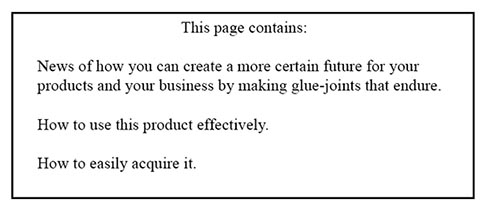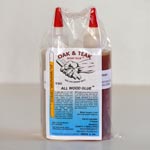Smith's


This easy-to-use glue is designed for a production environment as well as the craftsman or hobbyist, with a long working time to reduce waste and a simple fifty-fifty mixing ratio.
Testimonial:
Smith's Oak and Teak Epoxy Glue™ will glue all oily hardwoods. It will also (with proper chemical surface preparation) glue a wide variety of metals, glass, rubber and plastic materials. The cured adhesive is completely waterproof and weatherproof.
Our expertise in molecular engineering has allowed us to make Smith's Oak and Teak Epoxy Glue largely from the natural resins of wood itself. That is why it can dissolve the natural oils of oily hardwoods, and why it bonds all oily hardwoods. Epoxy glues made from petrochemicals cannot do this.
Smith's Oak and Teak Epoxy Glue is unaffected by the natural acids common to many woods, which is why it bonds oak so readily. This is why it is the All Wood Glue.
Smith's Oak &
Teak Epoxy Glue is the 2004 upgraded version of All Wood Glue, whose technology
is based on our Tropical Hardwood Epoxy, a product famous for thirty years
of gluing any wood known to man or beast.
Smith's Oak and Teak Epoxy Glue is the newest generation of products from
Smith & Co., embodying the new Smith's Dual Synergistic Catalyst™,
a breakthrough in the control of epoxy resin curing. This new technology
not only gives a long working time, but a cure twice as fast as older-technology
products. In addition, it will bring about an absolutely dependable full
chemical cure at temperatures down to 28°F (-2°C). This is done
while maintaining the flexibility and toughness which has been a hallmark
of Smith & Co. epoxy adhesives from the beginning.
Smith's Oak and Teak Epoxy Glue is intended to be mixed one-to-one by volume, and is forgiving of minor mix ratio errors. Mixing by weight may be done at 10 parts A to 12 parts B by weight.
The pot life [working time] is three hours at 50°F, ninety minutes at 68° F, and 45 minutes at 86°F. The corresponding times to reach full cure are 60 hours at 50°F, 30 hours at 68°F and 15 hours at 86°F. The underlying principle is that chemical reaction rates double about every 18 Fahrenheit degrees.
For best results mix in one container, transfer to a second container and mix again. Allow to sit 10 to 20 minutes before use, and allow to sit on wood joints with exposed end grain or exceptional roughness for at least ten minutes before assembly. Soft rubber pads under clamp faces will maintain an even pressure on the joint as excess glue is squeezed out. High clamping pressure will crush wood fibers directly under the clamps, leading to glue-starved joints in those spots, as well as wood-under-stress, and glued assemblies of highly stressed wood will readily fail. The reason for that is that the shear strength of wood [cleavage or splitting] parallel to the grain is very low. Gentle clamping, steam-bent or thin wood laminations and cross-grain fasteners or tenons, all these contribute to a long-lasting glued wood structure.
USING SMITH'S OAK AND TEAK EPOXY GLUE AS A CLEAR FILLER
Fine woodwork may be made from slabs of wood with known or unexpected surface defects that need to be filled. In many cases an opaque filler, colored to match the wood, does not look all-that-good, and a transparent fill would actually look much better. Here is how to do that:
Keep the wood entirely level; clean out any dirt or contaminants in the defects, and use my Oak and Teak Epoxy Glue. It is a self-leveling liquid, will stick to the wood, and will have only a slight amber tint that probably won't be noticeable. Mix per the below instructions, pour it into the defect and overfill a bit. This allows the inevitable small bubbles that will rise, to go to the glue surface that will be slightly proud of the wood surface.
When the glue has cured it may be sanded-back-to-flush with the wood surface. With successive grades of abrasive-sanding, the glue surface may be brought to essentially transparent, and the finishing-process for the entire piece may proceed.
Wet-sand with a hard flat block such as a piece of sandpaper stuck to a piece of plate glass with double-sided masking tape.
Buy abrasives by e.g., Norton, nothing Chinese; a good supplier of such is MSC, on-line (they will also send you a catalog; get one).
Use wetordry paper, either aluminum oxide or silicon carbide abrasive; garnet wears down too fast.
Start with e.g., 180-240. Sand with progressively finer grits to take out the sanding marks from the previous grit, e.g., perpendicular to the previous strokes with the coarser grit. A series of progressive grits are, e.g., 180, 240, 320, 400, 600, and ultimately 1200 grit or a white Scotchbrite pad.
Always wet-sand with soapy water, e.g., DAWN. The soap suspends the sanding debris in the water so it does not clog the paper and leave gouges in the surface being polished.
MIXING TWO-COMPONENT PRODUCTS
Sophisticated adhesives, sealants and coatings are two-component systems. One part has to be mixed with another part before they are applied. After a while, a chemical reaction takes place and what is created is a filler, paint or glue with exceptional properties. It is not possible to obtain those properties by taking some simple thing out of a can.
Each of these two parts, whether they are liquids or pastes, consists of very small parts called molecules. The manufacturer designed the system so that the individual molecules of each component would react with each other in certain proportions. That is why the instructions say to mix the materials in those proportions.
If the materials are mixed in different proportions, then some molecules of one-or-another component will not be used. They are left over, scattered among the molecules of both components that did react together. In that case, the material will be softer or weaker than it should be, or will soften in water when it should not. It might be a gooey mess. It is therefore important to mix the components thoroughly, so that everywhere in the mixture the ingredients are in the correct proportions, even down to the individual molecules. If the materials are portioned-out properly but not mixed thoroughly, then we will have too-many A-type molecules in one place, and somewhere else we will have too many B-type molecules. The net result of that is TWO places where it will not cure properly.
For example, we make the components A and B of our Fill-It Epoxy Filler to be different colors, so it will be easy for you to thoroughly mix the product. When you can see the streaks of different colors you know you must continue to smear, scrape, fold and mix until the color is uniform. The mixing tools themselves must be scraped occasionally. If mixing a paste on a flat surface, the mixing surface itself must occasionally be scraped off and the mixture folded-over itself a few times and then the smearing-and-scraping-and-folding mixing-action continued.
Our glues are all clear liquids, so even though one is colorless and the other amber, it is not always easy to thoroughly mix the liquid components. Here's how to do it: Measure out equal volumes of the two components into one container. Mix thoroughly in that container, scraping off the mixing-stick on the edge of the container occasionally. Then scrape out the entire contents into a second container and mix all-over-again. If you are not sure you got it all mixed, scrape everything into a third container and mix again. In this manner, the unmixed bits near the bottom corners of the first container become right-in-the-middle at the top of the second container, and then the entire mixing process can be really complete. If thoroughly mixed right down to the level of the individual molecules, the product will cure into the high-quality glue or filler it is supposed to become.
If there are any soft or gooey spots in the final cured product, that actually proves the material was not thoroughly mixed. I know you want to get good results; the foregoing is how to get that, with mine or anyone else's products.
DURABILITY OF GLUED WOOD
Wood expands differently it in its three dimensions: axial, radial (quartersawn) and tangential (plainsawn).
Joint design and the relative (meaning differential) expansion and contraction between different pieces of wood determine the shear forces generated across the bond-line, whether due to temperature variations or wood moisture content variations.
Ideally, wood should be conditioned and glued at the atmospheric moisture-content where it will see service, meaning in some cases built-where-it-will-be-used.
Thicker glue lines will absorb more shear displacement.
Eventually, the shear strength of the wood itself is the limiting factor, as softer woods may shear next-to-the-glue-line and wet wood has a much lower shear strength than dry wood. That is a very good reason for joints to be glued-and-screwed.
It is critical that surfaces to be glued be sanded first, to ensure the removal of even a very thin, colorless film of Mill Glaze.
Cure times vary with temperature; chemical reaction rates double roughly every 18 F degrees. While in most cases the joint will be able to be unclamped and handled the next day (warm weather) or in 2-3 days (cooler weather); ultimate cure proceeds more-slowly with every further increment of time; example: in my lab 60% cured (decent handling strength) in 16 hours, half-way-further in another 24 hours (meaning 80% cured, 20% uncured), half-way-further in another 24 hours (meaning 90% cured, 10% uncured), half-way-further in another 24 hours (meaning 95% cured, 5% uncured), and you can see that's why folks that make this-kind-of-stuff say "ultimate properties will be obtained in a week-or-two". It's how long it takes for the glue adhesion-strength and glue-polymer-strength to get up to the shear strength of the wood, whatever-that-happens-to-be.
I've had folks use my Oak and Teak Epoxy Glue and its earlier versions going back to the early 1970s in climates all-over-the-map on a wide range of woods and had excellent results.
Smith's Epoxy Cleanup Solvent™ will dissolve and clean up any epoxy glue before it has gelled. Once cured, there is no cleanup solvent.
© copyright 1972 - 2018, Steve Smith,
reprinted with permission

Technical Papers:
How to Glue and Repair Wood with Epoxy
You can glue all these kinds of Wood
Visit our new website for the Modern view.
You can order this product now from:
Smith
& Co.
Northern CA
1-800-234-0330
Buy Oak & Teak Epoxy Glue in Scandinavia
For other locations
or outside of the U. S.
call Smith & Co.; we can serve anyone
with any quantity directly from the Factory Store.

